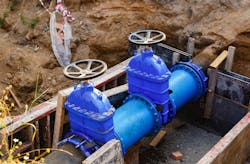The Infrastructure Bill and America’s Aging Water System
By Slawomir Platta - Trial Attorney, The Platta Law Firm PLLC
It’s no secret, America’s aging water infrastructure is in dire need of repair. According to the American Society of Civil Engineers’ 2021 U.S. infrastructure report card, the United States gets a D+ in wastewater systems and doesn’t fare much better in drinking water with a barely passing C- grade.
Currently, there are more than two million miles of underground pipes responsible for supplying clean water to all Americans. However, the majority of these pipes are rapidly deteriorating, posing health risks to millions. Simply put, aging pipes threaten water quality by seeping pollutants such as lead into the water they carry.
While lead pipes were banned by Congress more than 30 years ago, somewhere between six and seven million remain in service according to the American Water Works Association. In an effort to prevent lead from leaching from the pipes into the water, chemicals are often used. This approach is by no means infallible, as lead exposure in drinking water throughout the United States remains a problem. Perhaps nowhere was this health hazard brought to light more than in Flint Michigan where the change in water supply from Detroit to the more corrosive Flint River resulted in dangerously high levels of lead in the water.
However, it’s not just in Flint where the ill effects of contaminated water are being felt. “Many water systems across America still have lead transmission lines, and many homes (especially older ones) have lead pipes, fixtures, and solders. All of this allows lead to leach into drinking water,” said John Gautreaux, a senior water treatment plant operator in Houma Louisiana. The White House says lead pipes continue to serve an estimated 400,000 schools and childcare centers and 6 million to 10 million homes.
Today, over half a million children in the United States have elevated levels of lead in their blood stream, based on CDC reports. That’s because most of the drinking water infrastructure in the U.S. was built more than 50 years ago. In older cities, water pipes may have been in the ground for a century or longer. It’s no wonder a water supply line in the U.S. cracks every two minutes, resulting in a loss of six billion gallons of water every day.
As conditions currently stand, both rural and urban regions are poorly prepared to meet projected increases in water usage as population growth climbs. Fortunately, the U.S. government has taken a big step in the right direction to address the seriousness of the situation.
The Single Largest Investment in Water Ever Made by the U.S. Government
Thanks to the recently passed Infrastructure Investment and Jobs Act—a once-in-a-generation $1.2 trillion investment in our country’s declining infrastructure—funding to the tune of $50 billion is now in place to begin the arduous task of repairing and replacing America’s aging water delivery system. The Environmental Protection Agency (EPA) calls it “the single largest investment in water that the federal government has ever made.”
Some of the most significant distributions include $11.7 billion to the Drinking Water State Revolving Fund, with an additional $5 billion to Water Infrastructure Improvements for the Nation Grants as well as $4 billion to the fund earmarked specifically for “emerging contaminants.” Possibly the most important contribution in regard to long-term health effects is the $15 billion allocated for lead service line replacement to begin renovating and decreasing lead contamination in the country’s water lines.
What This Means
With up to 10 million lead service lines still being used in towns and cities throughout the nation there’s a monumental need for the repair and replacement of our aging pipes—many of which are present in low-income neighborhoods and communities of color.
Thanks to the funds now being made accessible through the Infrastructure Bill, millions of American children and adults will no longer have to worry, or even worse, experience the detrimental health effects brought on by lead and other contaminants in their water. As the work begins on improving America’s massive water system, a growing number of plagued communities will soon be protected from exposure to these dangerous pollutants.
Economic Benefits
There’s another winning element to this nationwide water line overhaul—greater job opportunities and income potential. It’s clear to see that investing in our country’s water infrastructure will not only affect people’s ability to thrive and become more productive, but also offer valuable economic benefits. With the injection of billions of dollars in federal funding, a multitude of good-paying jobs will become available to those who are qualified. As a matter of fact, several studies by nonpartisan groups and state health agencies have demonstrated a 2-to-1 return on investment for the repair and/or replacement of lead pipes.
It’s now time for contractors and utility workers to roll up their sleeves and prepare for the herculean job of making the repairs and replacements needed to fix America’s ageing water infrastructure. They must do it wisely, also considering worker safety and following federal and local guidelines to protect workers’ rights. Taking it one step at a time while balancing water needs and customer expectations is the most sensible approach. Contractors must first determine those water line locations most in need of repair and encourage residents and community leaders to get on board with the work that needs to be done.
